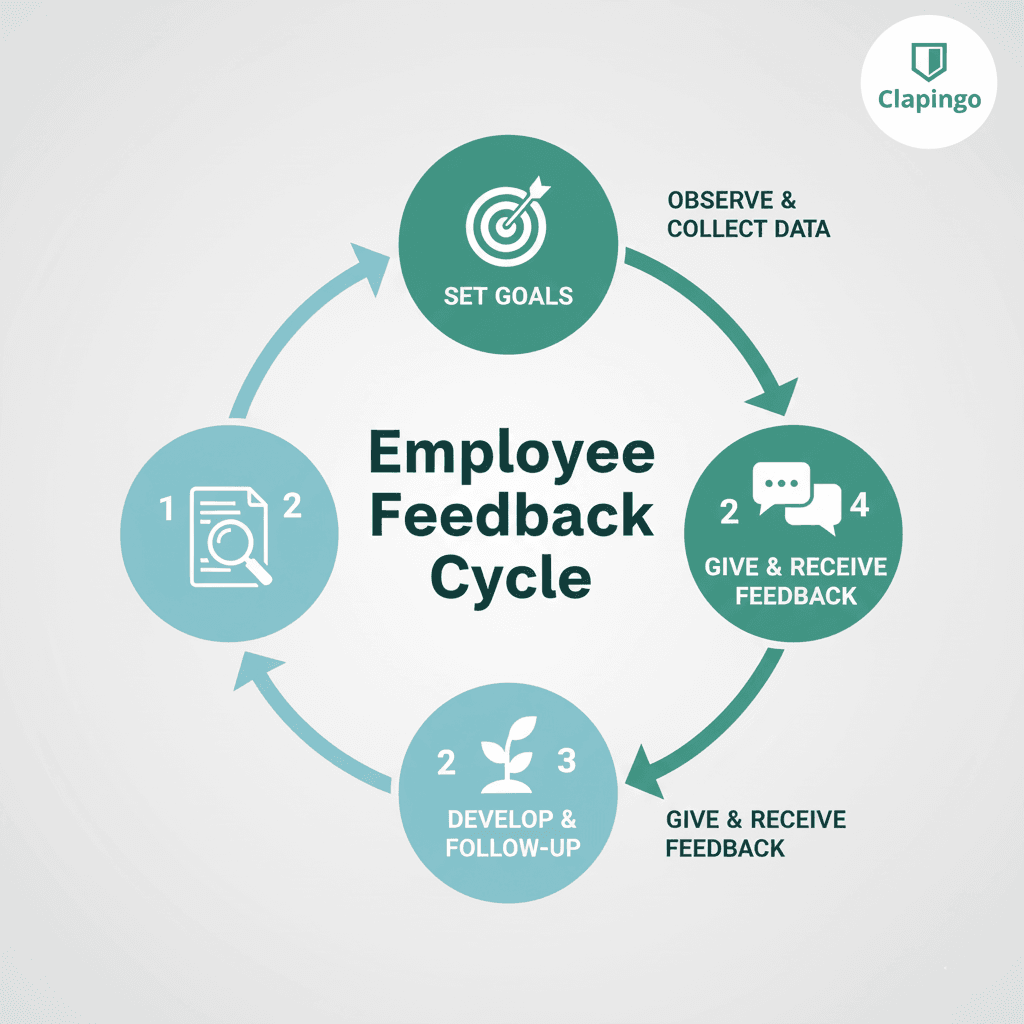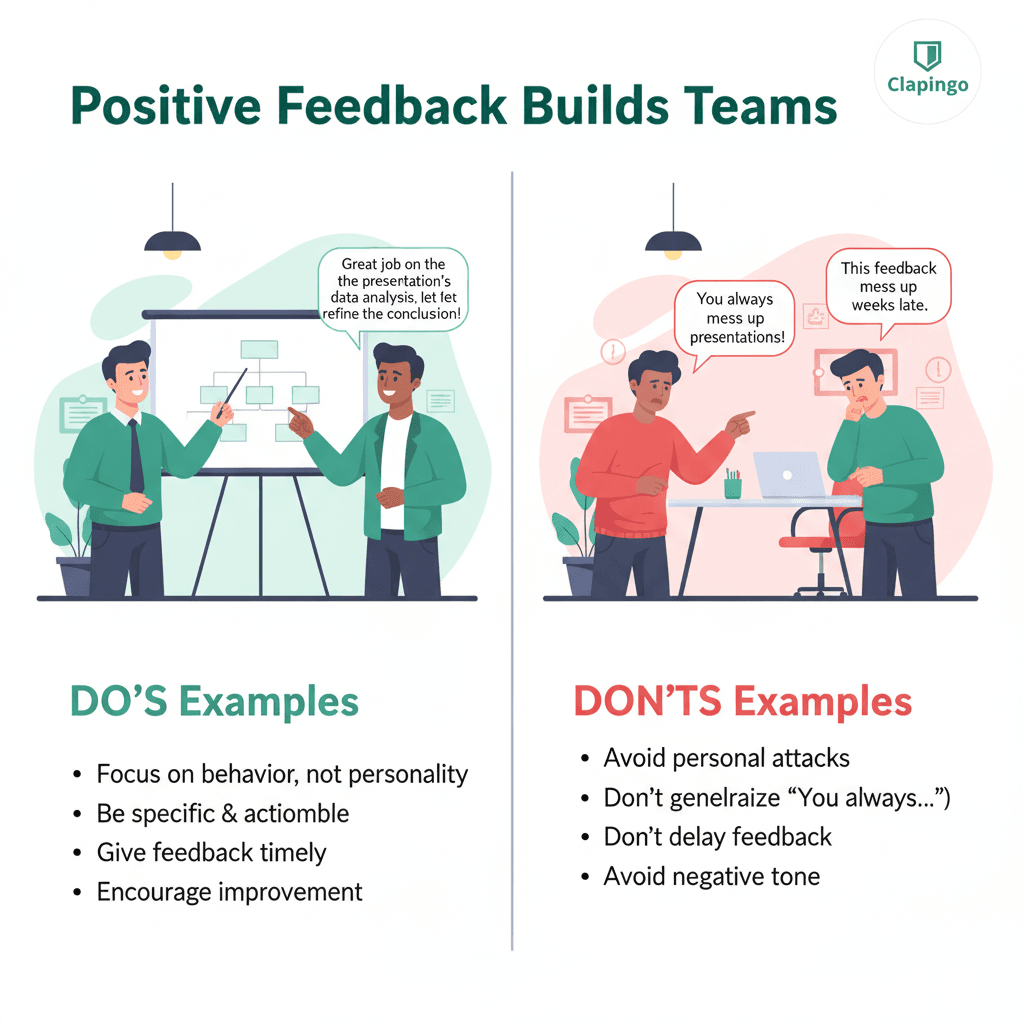Employee Feedback: How to Make the Most of It?
Discover the power of workplace feedback and how it drives professional growth. Learn practical tips, strategies, and tools like Clapingo to make the most of feedback at work.

The Importance of Employee Feedback
Why Feedback is the Lifeblood of Workplace Success
Feedback in the workplace is more than a performance review—it’s a growth compass. It tells employees where they stand, what they’re excelling at, and where they need to improve. When done well, workplace feedback strengthens trust, improves communication, and accelerates professional growth.
But here’s the truth: many employees either fear feedback or don’t know how to act on it. This blog will break down what workplace feedback really means, why it matters, and how you can make the most of it to grow in your career.
What is Workplace Feedback?
Workplace feedback is information exchanged between managers, peers, and employees about performance, skills, and behavior.
It comes in different forms:
Positive feedback – Recognition of good work.
Constructive feedback – Suggestions for improvement.
Developmental feedback – Guidance to help you grow long-term.
Did You Know?
According to Gallup, employees who receive regular, meaningful feedback are 3.5 times more likely to be engaged at work.
Why is Workplace Feedback Important?
Feedback is a two-way street. It benefits both organizations and employees when done right.
Benefits for Employees:
Clear understanding of strengths and weaknesses.
Roadmap for skill development.
Boost in confidence and motivation.
Benefits for Employers:
Higher employee engagement.
Improved performance.
Stronger workplace culture.
Clapingo Pro Tip: Don’t view feedback as criticism. See it as a mirror showing you how others perceive your work.
Types of Workplace Feedback
Not all feedback is created equal. Let’s look at common types:
Formal Feedback
Delivered in performance reviews, appraisals, or official meetings.
Informal Feedback
Quick suggestions, appreciation, or corrections during daily work.
Peer-to-Peer Feedback
Feedback exchanged among colleagues at the same level.
360-Degree Feedback
Input collected from managers, peers, subordinates, and sometimes clients.
Common Challenges with Workplace Feedback
Despite its importance, feedback often fails due to:
Vague comments like “Do better.”
Employees taking feedback personally.
Managers lacking the skill to deliver it effectively.
Lack of follow-up after feedback is given.
Clapingo Tip: Just like learning English fluency requires feedback on mistakes, growing at work requires specific, constructive guidance.
How to Receive Workplace Feedback Effectively
Many employees struggle not because feedback is harsh, but because they don’t know how to process it.
Here’s how you can receive feedback like a pro:
Listen actively without interrupting.
Stay calm and avoid being defensive.
Ask clarifying questions if feedback is vague.
Reflect and act—create an action plan to improve.
How to Give Effective Feedback at Work
Giving feedback is an art. Managers and colleagues should focus on:
Being specific: Instead of saying “You need to improve communication,” say, “In the last meeting, your presentation was strong, but you spoke too fast.”
Balancing positives and improvements: The "sandwich method" (positive → improvement → positive) works well.
Focusing on behavior, not personality.
Example: Instead of “You’re careless,” say, “The report had some errors in the data. Let’s work together on proofreading.”

Employee Feedback Cycle
The Link Between Workplace Feedback and Professional Growth
Feedback is not just about fixing mistakes, it’s about unlocking your potential.
Skill Development: Feedback highlights what to learn next.
Career Advancement: Employees who act on feedback grow faster.
Confidence Boost: Positive feedback reinforces self-belief.
Clapingo Connection: Just like regular practice on Clapingo helps learners grow in English fluency, consistent feedback helps employees progress in their careers.
How Clapingo Can Help You with Feedback in Communication
One of the biggest struggles employees face is communication in English. Many avoid feedback conversations because they lack confidence in expressing themselves.
Clapingo offers:
One-on-one spoken English sessions with feedback from mentors.
Practice for workplace scenarios like presentations, interviews, and meetings.
Constructive correction that improves fluency without judgment.
With Clapingo, feedback doesn’t feel like criticism, it feels like growth.
Real-Life Examples of Feedback in Action
Case 1: An employee receiving feedback about time management improved productivity by using scheduling tools.
Case 2: A manager learned to give constructive feedback through leadership coaching, reducing employee turnover.
Case 3: A Clapingo learner improved workplace English after consistent mentor feedback and landed a promotion.
Tips & Tricks to Make the Most of Workplace Feedback
Request feedback regularly instead of waiting for reviews.
Keep a feedback journal to track progress.
Act fast, implement changes quickly.
Celebrate improvements to stay motivated.
Learn to differentiate between constructive criticism and negativity.
Did You Know?
65% of employees want more feedback than they currently receive.
Regular feedback increases employee performance by up to 12%.
Feedback-rich cultures reduce turnover by 14.9%.
The Psychology Behind Feedback: Why We React the Way We Do
Employee Perspective:
Receiving feedback can trigger emotional reactions—defensiveness, embarrassment, or anxiety—especially if phrased harshly. Understanding that feedback is about behavior and not identity helps manage emotions better.
Employer Perspective:
Managers should deliver feedback in a psychologically safe environment. Using empathy and clarity ensures employees focus on the message, not the tone.
Tip: Replace “You did this wrong” with “Here’s what we can try next time.”
Feedback Timing: When You Say It Matters
Employee Perspective:
Employees appreciate timely feedback, it helps them correct mistakes while tasks are fresh in mind. Delayed feedback can feel irrelevant or punitive.
Employer Perspective:
Timely, real-time feedback prevents performance dips. Waiting till year-end reviews can lead to missed learning opportunities.
Clapingo Insight: Just as instant correction improves English fluency faster, instant feedback at work accelerates learning.
Feedback in Remote Work Settings
Employee Perspective:
In remote setups, feedback often comes through text or video calls—making tone easy to misinterpret. Employees should clarify meaning before jumping to conclusions.
Employer Perspective:
Leaders must be extra intentional using video calls or personalized messages to ensure feedback feels human, not robotic.
Clapingo Pro Tip: Start with appreciation, end with a specific action item.
The Role of Language and Communication in Feedback
Employee Perspective:
Sometimes, the message isn’t hurtful—the language used makes it so. Employees should learn to differentiate tone from intent.
Employer Perspective:
Simple, respectful language ensures clarity. For multilingual workplaces (like in India), using easy English can prevent misunderstandings.
Clapingo Spotlight: Clapingo’s one-on-one sessions help professionals communicate feedback confidently and politely in English.
Cultural Differences in Giving and Receiving Feedback
Employee Perspective:
In some cultures, direct feedback feels rude. In others, it’s a sign of honesty. Employees must understand workplace culture to interpret feedback correctly.
Employer Perspective:
Leaders in diverse teams should be culturally sensitive—what motivates one employee might discourage another.
Did You Know?
In India, over 70% of employees prefer indirect feedback, whereas Western workplaces favor straightforward communication.

Effective Employee Feedback Builds Teams
How to Create a Feedback-Friendly Workplace Culture
Employee Perspective:
Employees can encourage open dialogue by asking for feedback and giving constructive input to peers respectfully.
Employer Perspective:
Organizations should normalize feedback through weekly check-ins, peer recognition boards, or “Feedback Fridays.”
Clapingo Pro Tip: Recognition and suggestions should go hand-in-hand; appreciate what’s working, then discuss what can improve.
How Feedback Improves Leadership Skills
Employee Perspective:
By receiving feedback, employees learn to handle criticism maturely—an essential leadership quality.
Employer Perspective:
Great leaders are feedback magnets. They actively seek opinions, admit mistakes, and grow from others’ insights.
Clapingo Analogy: Just like advanced English speakers practice listening to refine fluency, strong leaders listen deeply to refine leadership.
The Feedback Loop: From Reaction to Action
Employee Perspective:
Feedback without follow-up becomes noise. Employees should turn suggestions into measurable action plans.
Employer Perspective:
Managers must schedule feedback follow-ups—this accountability builds trust and progress tracking.
Example:
“Last month you mentioned I should improve time management. Here’s how I’ve applied that advice.”
How to Encourage Upward Feedback (Employees to Managers)
Employee Perspective:
Speaking up can feel risky, but upward feedback strengthens collaboration and shows initiative. Use respectful, specific language like, “I think meetings could be shorter if we share agendas earlier.”
Employer Perspective:
Leaders should create safe channels for upward feedback—like anonymous surveys or open forums.
Clapingo Tip: True leadership invites opinions, not obedience.
Turning Feedback into a Continuous Learning Habit
Employee Perspective:
Make feedback part of your weekly routine. Reflect on what went well and what didn’t—just like language learners do after every session.
Employer Perspective:
Encourage a “growth mindset” culture where mistakes are treated as learning moments, not failures.
Clapingo Callout:
“Just like English fluency builds through consistent correction, professional growth blooms through regular feedback.”

Effective Feedback = Career Growth
How Clapingo Can Help You Make the Most of Workplace Feedback
Many professionals understand feedback — but struggle to act on it because of one big barrier: communication confidence.
You might know what to say, but hesitate to express it clearly in English during meetings, reviews, or discussions.
That’s where Clapingo comes in.
1. Build Confidence in Feedback Conversations
Clapingo’s one-on-one spoken English sessions are designed for real workplace situations from performance appraisals to team discussions. You’ll learn how to:
Respond gracefully to constructive feedback.
Ask clarifying questions in polite, fluent English.
Express gratitude and confidence without sounding defensive.
Example: Instead of saying “I didn’t do wrong,” you’ll learn to say “Thank you for the feedback. I see where I can improve.”
2. Learn the Language of Professional Growth
Through interactive sessions, Clapingo mentors help you practice phrases and tone used in modern workplaces.
You’ll master:
Polite disagreement (e.g., “I see your point, but may I share a different perspective?”)
Diplomatic self-advocacy (e.g., “I’d like to highlight some of the results achieved since our last feedback discussion.”)
Confident vocabulary for performance reviews, client calls, and presentations.
3. Personalized Feedback, Every Session
What makes Clapingo powerful is its live mentor feedback. After every session, your tutor corrects pronunciation, word choice, and fluency — in real time.
It’s not theory; it’s practice with personalized guidance, just like workplace coaching.
Think of it as your daily “performance review” but one that builds confidence instead of stress.
4. Transform Feedback Into Progress
On Clapingo, every conversation is a feedback opportunity. You learn how to:
Receive constructive comments calmly.
Turn advice into action steps.
Communicate assertively in English while staying respectful.
The more you practice, the better you become at using workplace feedback to fuel professional growth.
5. Designed for Indian Professionals
Clapingo understands the Indian workplace culture where English proficiency often affects promotions, leadership opportunities, and confidence.
With mentors who guide you in simple, practical English, you’ll no longer fear feedback sessions or English-heavy meetings.
Book a Clapingo demo today.
Conclusion: Turning Feedback into Fuel for Growth
Workplace feedback is not something to fear, it’s the secret ingredient to professional growth. By learning to give, receive, and act on feedback effectively, you can accelerate your career and build stronger workplace relationships.
With platforms like Clapingo, you can also sharpen your communication skills to handle feedback conversations with confidence. Remember, feedback is not the end of the road, it’s the signpost guiding you toward success.
Read Also: How to Negotiate Salary in English - Smart Negotiation Tips for Success
Comments
Your comment has been submitted successfully!